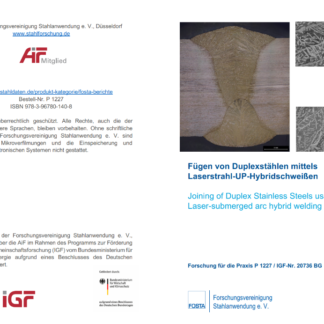Description
P 1227 – Joining of Duplex Stainless Steels using the Laser-submerged arc hybrid welding
Due to their excellent properties, duplex steels are used for applications subject to corrosion in the oil and gas industry as well as in shipbuilding and bridge construction. In addition to corrosion resistance, such steels are characterized by high strength and toughness, which is due to a delta ferrite-austenite microstructure ratio with at least 30 % austenite. During welding, this microstructure ratio can be lost due to unfavorable heat input. Arc welding processes, such as submerged arc welding and gas metal arc welding, have become established in practice for welding duplex steels. These welding processes can produce joints with the required microstructure ratio, but at the tradeoff of low productivity. In contrast, the beam welding processes laser beam welding or electron beam welding exhibit high productivity but cannot produce welded joints with the required microstructure ratio. Laser beam-SA hybrid welding combines the advantages of both welding processes and can be a good alternative with high productivity.
The aim of the research project was to be able to produce weld seams on duplex steel 1.4462 (up to 30 mm) with high weld seam quality in terms of the mechanical-technological properties and corrosion resistance using laser beam-SA hybrid welding with a high process efficiency and stability. In the course of the welding process developments, welded joints are produced from the duplex steel 1.4462 by varying the process parameters, e. g. laser beam power, feed rate and oscillation amplitude, and evaluated with regard to metallurgical and mechanical properties on the basis of standards or regulations. Cross-sections, EDX analyses, microstructural analyses, Charpy impact tests, tensile tests and corrosion tests are used for weld qualification. As a major result, efficient high-performance welding processes with a laser beam power of up to PL = 16 kW and a submerged-arc power of PUP = 15 kW at a welding speed of up to vS = 1.0 m/min could be achieved. The welds produced exhibit no critical imperfections and for the most part achieve the required austenite content of 30 % and the required impact energy of KV-min = 40 J at a test temperature of −40 °C, as well as corrosion resistance in line with requirements. Based on these results, laser beam-SA hybrid welding has been shown to be a process-reliable welding method with high productivity, which can play an important role in the welding production of components made of duplex steels in the future.
All research reports in german language only!
Published in:
Juy 2022
Authors:
Dipl.-Ing. M. Puschmann, P. Urbanek, Dr.-Ing. F. Riedel, Prof. Dr.-Ing. St. Kaierle, Dr.-Ing. R. Lahdo, Dr.-Ing. S. Nothdurft, Dr.-Ing. J. Hermsdorf


